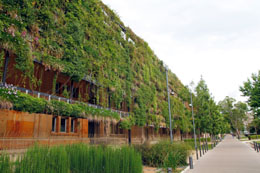Vertical gardening is a method of growing plants in an upright form by making use of stakes, cages, trellis, and other vertical supports. It has many advantages like harvesting a high crop yield, plants are less susceptible to pests, etc. Read this article before you initiate a vertical garden of your own.

Vertical gardening is an ideal option for those staying in city areas, where agricultural land is limited. Plants can be trained for growing vertically by making use of suitable supports or frames. As plants grow upright naturally, training plants to extend upwards is not so difficult. The basic principle of vertical garden is more or less similar to hydroponics. The plant root system is supported with a fibrous material that is supplemented with plant nutrients. Watering the plants is done via the support material.
This kind of a garden can be created and maintained indoors as well as outdoors. Many times, vertical spaces are left in the traditional method of gardening. Let's take an example of a vegetable garden where wide spaces are left between the vegetable rows. These spaces can be used to plant crops or other vegetables.
The first and foremost step is to select a proper location. The location should be such, that it does not shade out other plants. There should be optimum sunlight for the plants in the vertical garden. Hence, considering these factors, you should orient the vertical supports in a proper direction.
To ensure long-term benefits, always opt for a metallic frame or support. Vertical gardening requires more water than the traditional way of gardening. In order to reduce moisture evaporation and retain water in the soil, it is always advisable to practice mulching. Mulching also helps in supplying additional plant nutrients.
Another basic tip is to train the plants, otherwise there are chances of the plants spreading in an unmanageable manner. If necessary, you can trim the plants without disturbing the root system. While doing so, also make sure that the overall growth of the plants is not affected.
In order to have easy access to all plants, you can make use of a ladder. This will help you in maintaining the plants and pruning (if necessary). When the plants achieve full growth, you can fasten them to the support or structure to prevent falling. Twine is a good option for tying the plants. Few vegetables that can be grown successfully are tomatoes, cucumbers, and bell peppers. For decoration purposes, you can consider planting ivy plants.
One of the major advantages of vertical gardening is harvesting maximum products in a minimum space.
- Some of the highly spreading plants (e.g. vining winter squash) can be grown effectively in a vertical garden.
- This type of gardening is best suited for plants that require maximum sunlight.
- Plants grown in a vertical garden are less accessible to diseases and pests.
- Easy access to ripe fruits and vegetables, hence crop harvesting or cultivation is easier.
- It provides adequate aeration to the plants.
- Vertical gardening increases the beauty of the garden.
In addition, it can be used to create privacy screen and to cover an unattractive structure. People who are disabled can opt for vertical gardening, as it requires minimum bending. Overall, the yield of vertical gardening is higher than traditional plantation methods.






 Vertical gardening is an ideal option for those staying in city areas, where agricultural land is limited. Plants can be trained for growing vertically by making use of suitable supports or frames. As plants grow upright naturally, training plants to extend upwards is not so difficult. The basic principle of vertical garden is more or less similar to hydroponics. The plant root system is supported with a fibrous material that is supplemented with plant nutrients. Watering the plants is done via the support material.
Vertical gardening is an ideal option for those staying in city areas, where agricultural land is limited. Plants can be trained for growing vertically by making use of suitable supports or frames. As plants grow upright naturally, training plants to extend upwards is not so difficult. The basic principle of vertical garden is more or less similar to hydroponics. The plant root system is supported with a fibrous material that is supplemented with plant nutrients. Watering the plants is done via the support material.